#polyclad flatworms
Explore tagged Tumblr posts
Text
Made an edit lol
19 notes
·
View notes
Text



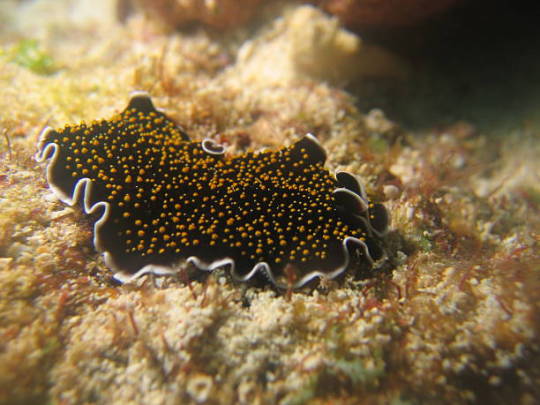


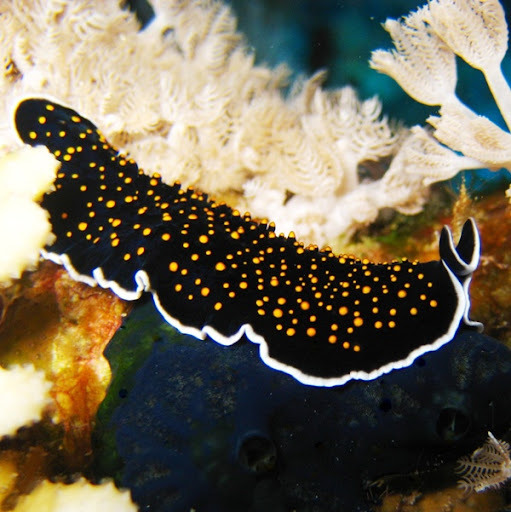




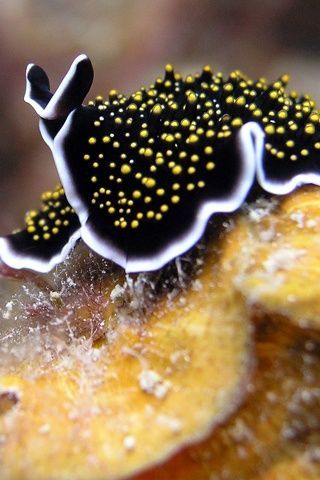

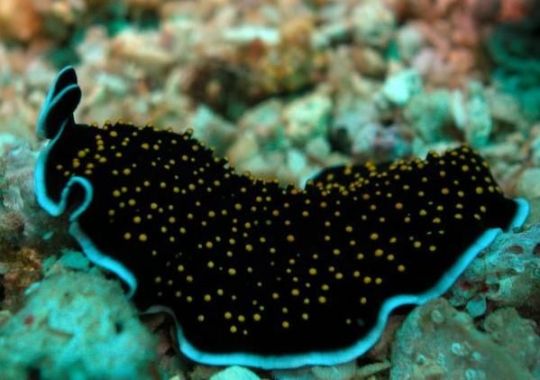


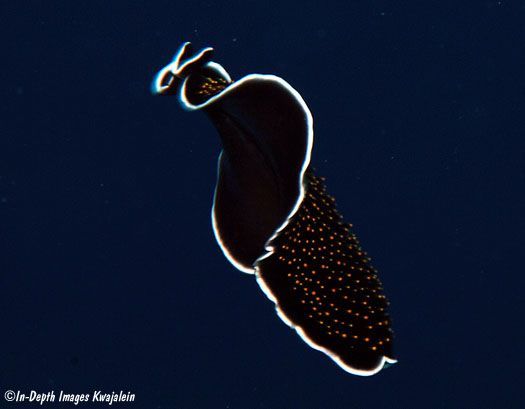

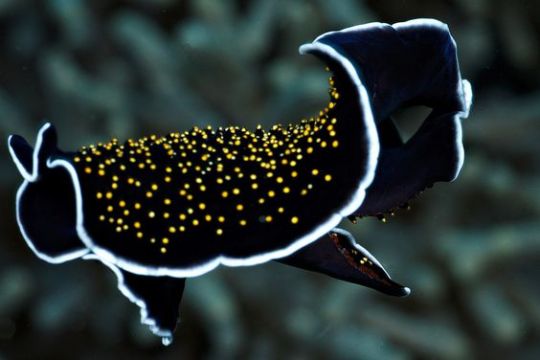
Червь плоский желтопятнистый (Thysanozoon havomaculatum) . Морской червь из класса ресничные черви, или турбеллярий. Принадлежит отряду Поликлад. Имеет уплощённое, овальное тело, покрытое ресничным эпителием. Длина этого симпатичного создания около 4 см, а толщина всего пару миллиметров. Передний конец его тела несёт пару щупалец. Мускулатура этого плоского червя многослойная, хорошо развитая, благодаря ей он способен подниматься в толщу воды за счёт ундулирующих движений краёв тела, а не только обитать на дне. Этот свободноживущий плоский червь питается преимущественно как хищник, водными беспозвоночными. Встречается в морях вокруг Австралии и Индонезии.
Yellow-spotted flatworm (Thysanozoon havomaculatum). A marine worm from the class of ciliated worms, or turbellarians. Belongs to the Polyclad squad. It has a flattened, oval body covered with ciliated epithelium. The length of this cute creature is about 4 cm, and the thickness is only a couple of millimeters. The front end of its body bears a pair of tentacles. The musculature of this flatworm is multi-layered, well developed, thanks to it it is able to rise into the water column due to undulating movements of the edges of the body, and not just live on the bottom. This free-living flatworm feeds primarily as a predator on aquatic invertebrates. It is found in the seas around Australia and Indonesia.
Источник:https://t.me/+t0G9OYaBjn9kNTBi, //www.webdive.ru/fotocat.php?t=11&id=20542&mode=view, http://mylongdongbay.blogspot.com/2007/07/save-ocean-cherish-marine-lives.html, /ru.pinterest.com/pin/630644754053053958/, http://www.akkiira.com/hiramushi/yoimiyaminohiramusi-swimming.html, //foxford.ru/wiki/biologiya/tip-ploskie-chervi?utm_referrer=https%3A%2F%2Fwww.google.com%2F.
#fauna#video#animal video#marine life#marine biology#nature#aquatic animals#Polyclad#Yellow-spotted flatworm#ocean#sea#corals#plankton#animal photography#nature aesthetic#видео#фауна#природа#Поликлады#Червь плоский желтопятнистый#океан#кораллы#планктон#море
938 notes
·
View notes
Text
🪱TAPEWORMS🪱
This is gonna be a post about tapeworms, as requested by @cryptidwithacopiccollection and @budgetairlines
Tapeworms (Cestoda) are a type of endoparasitic flatworm (Platyhelminthes). Flatworms are a fun phylum of worms that are mostly parasitic with the exception of the class Turbellaria, which can be free living. Sadly this post is not about them, but have a nice picture of a Polyclad flatworm anyway :)
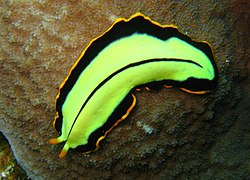
Flatworms in general lack a circulatory and respiratory system, and so have to do all their gas exchange via diffusion through their skin. This is why they have to increase their body's surface area in relation to their body's volume, as shown in this expertly drawn diagram:
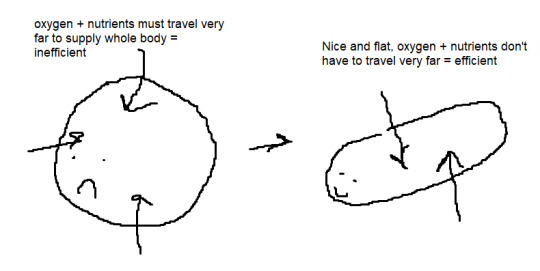
Tapeworms achieve a high surface area to body volume ratio by being really long and thin. Surface area is especially important to them, as unlike some other flatworms, they actually lack a digestive system! They just do all eating and excretion through their skin via diffusion. Being an endoparasite (a parasite that lives inside its host), they can afford to be lazy and let their host do all the hard work.

The family of tapeworms this post will be focusing on is Taeniidae. They have a very simple body plan consisting of a head (called a scolex), a neck (no fancy name), and a long segmented body (called a strobila). I've seen varying reports on how long they can get, but 15-30 feet seems like the typical size, which is horrifying. The segments that make up the strobila are called proglottids and each one contains a male and female reproductive tract, so can produce both sperm and eggs. Proglottids are generated from the neck and get pushed along the strobila where they mature and eventually shed into the host's intestines, which then get excreted into the environment. A single tapeworm can produce thousands of these things, increasing their chances at infecting another host.

Basically, a tapeworm's life inside the intestine consists of holding onto the host's gut wall with its scolex and just hanging out there, absorbing nutrients from the host's digested meals. The method of attachment depends on the specific species, but it typically involves hooks and/or suction cups.
Like many parasites, their life cycle is complex and involves more than one host. In parasitology, a 'definitive host' refers to the host the parasite sexually matures and reproduces in, whereas an 'intermediate host' is any host an immature parasite infects along the way. To explain a tapeworm lifecycle, I will be using Taenia saginata as an example, which is a tapeworm that infects humans and cattle (Bare in mind that the definitive and intermediate hosts can vary depending on species). I will be naming this T. saginata Grungus and following its journey.
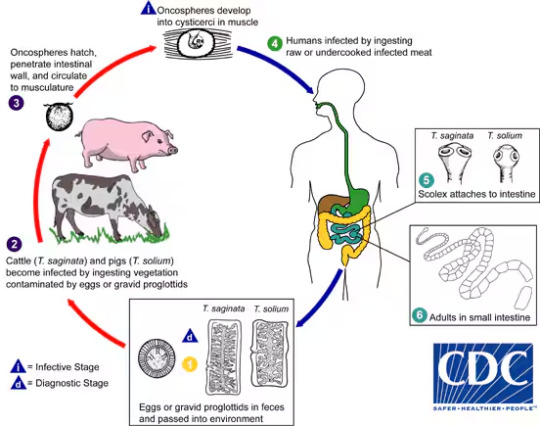
Grungus started life as an egg in the grass where it got eaten by a cow (the intermediate host). If needed, it could have survived outside for months or even years! Once inside the cow, the little embryo grungus felt comortable and hatched. It is currently in its larval form, known as an oncosphere. Grungus burrowed into the cow's intestinal walls and found a nice patch of muscle tissue to settle down in. It then developed into a cysticerci, sometimes refered to as a bladderworm due to its bladder-like shape. These appear as cysts in the muscle.
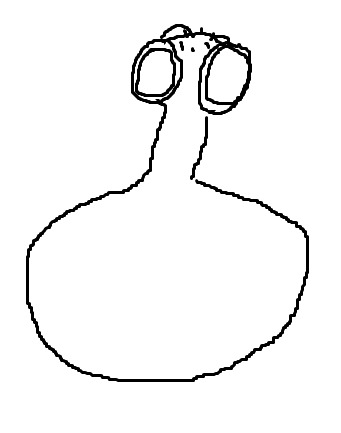
The cow got slaughtered for meat, which is unfortunate for the cow but very fortunate for Grungus. The human liked their steak rare, and so did not properly cook the meat before eating it, meaning Grungus survived and successfully made it into its definitive host. Here it was able to mature into a tapeworm, where it spent its days clinging to the intestinal wall and absorbing nutrients until it was sexually mature. It may meet another sexy tapeworm in the same intestines and mix some genetic material with it, or it may fertilise its own eggs if there's no hot singles in its area. Grungus could live to be up to 30 years old and during its life it will release many thousands of proglottids into the environment, allowing this beautiful cycle to continue <3
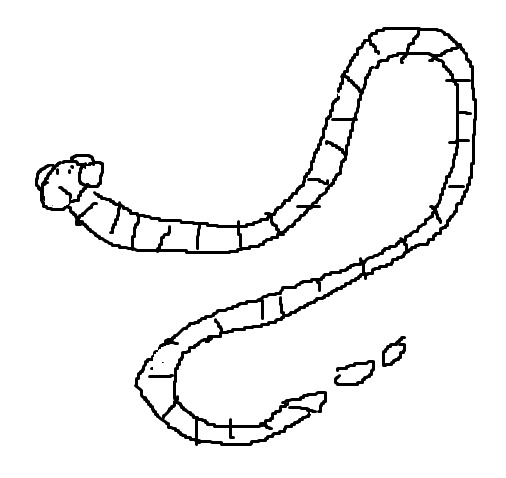
Usually, tapeworms in the intestines cause mild symptoms including stomach aches, weight loss and diarrhea, but these symptoms can vary and depend on the speices. Thankfully, they can be dealt with by taking anti-parasitic medication.
In rare cases, humans can eat the eggs of pork tapeworms and get infected by the larval form which burrow into the tissues and form a cysticerci instead of staying in the intestine. This can be very severe depending on where the cysticerci infection is located. For example, if they infect the central nervous system they cause neurocysticercosis which can be fatal in the most severe cases. Thankfully, this is rare and preventable by practicing good hygiene and cooking your pork properly, so don't panic.
Hope this was interesting to you weirdos!
#biology#parasitology#parasite#tapeworms#science#stem#stemblr#ms paint#cw gross#cw illness#cw sickness
23 notes
·
View notes
Text

[https://www.inaturalist.org/observations/101192130] Polyclad Flatworm || Prostheceraeus floridanus Observed in United States
#animals#worm#bugs#slug#nature#wildlife#photography#water beast#who cooks for queue? who cooks for queue all?
4 notes
·
View notes
Text
Sorry but if transformers bang it’s not like how we do it. I’m thinking like polyclad flatworms. Penis fencing. Loser gets stabbed. With the penis.
5 notes
·
View notes
Text
Although some of the larger marine flatworms are photogenic enough, to appear regularly in reef life guides and aquarium books, the mention of flatworms in reef aquariums usually relates to a small number of species, that are often labelled 'redbugs', or that actively eat coral tissues. These species are smaller, not so visually striking, and widely regarded as pests and not pets. This leads often to senseless panic, when quite harmless species of flatworms are encountered, such as Amphiscolops - not all of such 'hitch hiking' flatworms are bad.
However, conflicts do arise from the presence of corallivorous flatworms, such as those plaguing the acroporid corals, and the red or rust 'planarian' genus, or Convolutriloba, which accommodate photosynthetic symbionts. Convulotriloba sp. are not, as is often misreported, actual coral eaters themselves. Rather they compete with photosynthetic corals for access to light, and their populations can increase so fast, through fission, that they can simply swamp out the growing corals beneath them.
These flatworms are toxic, involving tetrodotoxin, and this defence seems to deter most foragers from guzzling them. Toxicity problematizes the potential of chemical treatments, because when the Convolutriloba flourish in quantities, their mass death causes the stressed and dying animals, to secrete toxins into the aquarium water. So although a chemical treatment might not itself harm corals etc, it can still be disastrous. As an aside, this genus dislikes settling where it is subject to strong current, and is therefore less likely to be troublesome in high flow systems or locations.
A number of fish and crustaceans will eat Convulotriloba sp. and other 'pest flatworms', but not eagerly enough for them to control their numbers properly, and this is likely because they bear toxins. So that a number of carnivorous foragers may nibble at Convulotriloba numbers, but are not willing to wulf them down, as aquarists would like them to. This fits what I and others have seen of foraging dragonets, wrasse, butterflyfishes, arrow crabs, and boxing shrimp. A closer examination may show that the worms are more often rejected after sampling as potential food.
The falsely named 'blue velvet nudibranch' - which is really a headshield slug, Chelidonura varians - reportedly dies after consuming only Convulotriloba. In nature Chelidonura sp. have a broad diet, including molluscs moreso than flatworms. Like the other foragers that consume red flatworms, their nature is surely to sample vagile animals, and then move on. In truth, chemically well defended organisms such as Convulotriloba sp. might not be immune to sporadic predation, but their arsenals would not have come to exist through natural selection, were they ineffective against bulk consumption.
More than one species of Convulotriloba is encountered in aquariums, but there is probably little need to fret about their identification. Another less notorious genus named Waminoa, has a similar carpeting habit, resting upon coral tissues, but is seemingly not so toxic to other animals, or their toxicity is not so well studied. Less is reported about Waminoa in relation to corals or other sessile organisms, or to their potential predators. It seems the usual flatworm consumers will eat them.
The other dreaded flatworms actually are obligate coral feeders, the Acropora and Montipora eating polyclads. Fortunately a number of regularly encountered reef fish and shrimp, will eat these flatworms at different stages of there life cycles. Pseudocheilinus wrasse are certainly proven to consume them under observation, although they appear to spit out Convulotriloba. The peppermint shrimps, a species complex of broad spectrum foragers, consume both the adult worms and their eggs. These are the same shrimp admired for their consumption of Aiptasia anemones, but for that reason they could also consume corals themselves.
Specialized coral feeding polyclads also bother other corals such as euphyllids, particularly Euphyllia senso stricto and the related Fimbriaphyllia, and may cause more damage than is often recognised. This is because the feeding of certain (but not all) polyclad flatworms on coral tissues, clearly damages and behaviorally stresses these corals. But the corallivorous flatworms may be difficult to spot, and to recognize for what they are, and problems with euphyllid polyp expansion are likely to often remain undiagnosed. A mixture of temporary dips and natural biological control is advised, but the strong stings of euphyllids may ironically deter flatworm eaters.
#pest flatorms#reef pests#biological control#red planarian#red flatworm#rust flatworm#Chelidonura varians#blue velvet nudi#blue velvet nudibranch#Convulotriloba#redbugs#acropora#montipora#corallivores#wrasse#shrimp#Waminoa#Euphyllia#Fimbriaphyllia
1 note
·
View note
Photo

Yellow papillae flatworm (Thysanozoon nigropapillosum) swimming at 40 ft (12 m) depth, Manta Ray Bay, Yap, Federated States of Micronesia.
photograph: Betty Willis | Wikipedia CC
51 notes
·
View notes
Photo
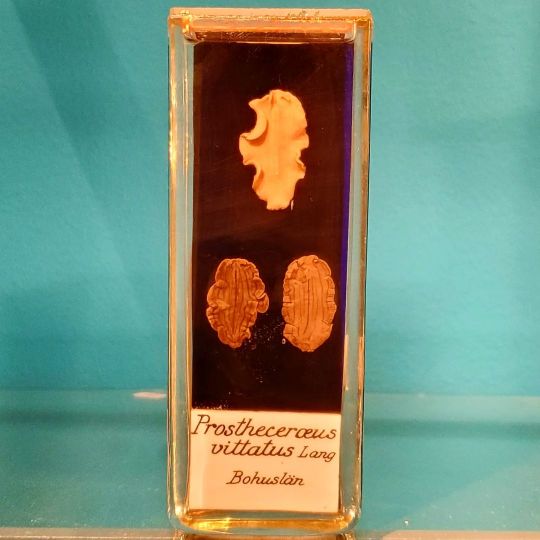
Taken 2022 22nd January, these are candy stripe flatworms (Prostheceraeus vittatus) @evolutionsmuseet being displayed. In Sweden, they occur on the west coast. They live in the intertidal to shallow subtidal zones hiding wherever possible, crawling over substrate using cilia, or gliding over it with sinuous motions. They will hunt other small invertebrates such as tunicates. #animal #animals #djur #wildlife #natur #naturliv #nature #naturalhistory #naturhistoriska #preservedspecimen #fauna #invertebrates #invertebrate #flatworm #flatworms #polyclad #polyclads #polycladflatworm #polycladflatworms #marineflatworm #marineflatworms #plattmaskar #plattmask #animalia #platyhelminthes #polycladida #euryleptidae #prostheceraeus #prostheceraeusvittatus #candystripedflatworm (at Evolutionsmuseet) https://www.instagram.com/p/CZaIIhiPNWY/?utm_medium=tumblr
#animal#animals#djur#wildlife#natur#naturliv#nature#naturalhistory#naturhistoriska#preservedspecimen#fauna#invertebrates#invertebrate#flatworm#flatworms#polyclad#polyclads#polycladflatworm#polycladflatworms#marineflatworm#marineflatworms#plattmaskar#plattmask#animalia#platyhelminthes#polycladida#euryleptidae#prostheceraeus#prostheceraeusvittatus#candystripedflatworm
1 note
·
View note
Text
Yellow-Spotted Flatworm (Thysanozoon nigropapillosum)
This is a Yellow-Spotted #Flatworm (Thysanozoon nigropapillosum). It is a #species of polyclad flatworms belonging to the family Pseudocerotidae. We spotted this lovely creature while diving off the coast of Fiji. #underwater #wildlife #nature #sealife
This is a Yellow-Spotted Flatworm (Thysanozoon nigropapillosum). It is a species of polyclad flatworms belonging to the family Pseudocerotidae. We spotted this lovely creature while diving off the coast of Fiji. Our dive guide referred to this enchanting invertebrate as a Yellow-Spotted Flatworm. However, it is also referred to as Gold-Speckled Flatworm, Yellow Papillae Flatworm, Yellow-Spotted…

View On WordPress
#ecotourism#Flatworm#marine biology#Nature#Scuba Diving#sea creatures#sea life#Underwater Video#wildlife
44 notes
·
View notes
Text



🌊🌊 🐚 BENTHIARY 🐚 🌊🌊 day 9-10 Thysanozoon nigropapillosum is a polyclad flatworm found in the Indo-Pacific. They have so many nicknames relating to their gold dots decorating their dark body; I think my favourite is gold speckled flatworm. I drew them as if they were an underwater nebula. They swim around in a hypnotizing undulating manner, and have these cute ears on their heads (kinda like snails?) ⭐️ 💫 🌟 I think I spent a lot of time narrowing down which flatworm I chose for my Benthiary prompt lol. There's too many that almost made the cut, like Pseudoceros susanae? What is even happening with them? Anyway, I've been busy with work a bit, but I'm still making time to do the rest of Benthiary _(。_°/

#art#art photography#traditional art#benthiary#benthos#marine art#marine life#flatworm#sea creatures#sea aesthetic#ocean life#ocean aesthetic#Thysanozoon nigropapillosum#art prompt#drawing prompt#colour pencils#ink illustration#illustration#artists on tumblr#illustrators on tumblr#scientific illustration#animal art#sketchbook#sketchbook art#art journal
21 notes
·
View notes
Text
Flatworm mimicry
Fun fact! Did you know that certain flatworms are mimicked by certain types of fish?
youtube
This is speculated to be from the flatworms TTX (Tetrodotoxin) content. More research is being conducted on the topic, but mimicry like this can be used to infer that the TTX content in flatworms is a defense mechanism. (Although, some studies show that there are high concentrations of TTX in the pharynx, or feeding organ, which has had scientists hypothesize wether or not TTX is used in prey capture.)
Very cool!!
4 notes
·
View notes
Text
Phylogenomics suggests that larvae are ancestral in polyclads, but not homologous to the trochophore
Platyhelminthes (flatworms) are a diverse invertebrate phylum that are useful for exploring life history evolution. Within Platyhelminthes, only two clades develop through a larval stage: free-living polyclads and parasitic neodermatans. Neodermatan larvae are considered evolutionarily derived, whereas polyclad larvae are hypothesized to be retained from the last common ancestor of Platyhelminthes - and Spiralia - due to ciliary band similarities among polyclad and other spiralian larvae. However, larval evolution has been challenging to investigate within polyclads due to low support for deeper phylogenetic relationships. To investigate polyclad life history evolution, we generated transcriptomic data for 21 species of polyclads to build a well-supported phylogeny for the group. We then used ancestral state reconstruction to investigate ancestral modes of development (direct vs indirect) within Polycladida, and flatworms in general. The resulting tree provides strong support for deeper nodes and we recover a new monophyletic clade of early branching cotyleans. Early branching clades of acotyleans and cotyleans possess diverse modes of development, suggesting a complex history of larval evolution in polyclads that likely includes multiple losses and/or multiple gains. Our ancestral state reconstructions in previous platyhelminth phylogenies also suggest that larval similarities between flatworms and other phyla are most likely convergently evolved http://dlvr.it/STwnRs
0 notes
Video
instagram
Interesting find in my sump. Creeping along the filter pad in my sump I found this Polyclad Flatworm (Phrikoceros mopsus). This specimen is quiet large and must have been in my system for quite some time. Polyclad Flatworms can get larger than the one in my sump. They do have a bad reputation and this involves their diet. They pursue and consume live meaty prey and it's easy to understand why they have a sweet tooth for clams and snails. Judging by its color it's easy to see why I have not seen this guy in my display tank. Just which I knew how this dangerous critter got into my tank. #coral #coralreef #coralreefs #coralreeftank #coralreefaquarium #coralporn #coralcritters #coralpests #reef #reefer #reefaquarium #reefporn #reefkeeping #reefs #reeffish #reefaddict #reeftanks #reefaholiks #reeftank #reefgeek #marineaquarium #saltwatertank #saltwateraquarium #allmymoneygoestocoral #allmymoneygoestofish #aquarium https://www.instagram.com/p/CFSQCtQJ1Ui/?igshid=12txfguyv8pbb
#coral#coralreef#coralreefs#coralreeftank#coralreefaquarium#coralporn#coralcritters#coralpests#reef#reefer#reefaquarium#reefporn#reefkeeping#reefs#reeffish#reefaddict#reeftanks#reefaholiks#reeftank#reefgeek#marineaquarium#saltwatertank#saltwateraquarium#allmymoneygoestocoral#allmymoneygoestofish#aquarium
0 notes
Text
hey if anyone knows where I can get a copy of “Marine Flatworms: the world of polyclads” by Leslie J Newman please let me know!!
0 notes
Text
Critter Identification: Leopard Polyclad Flatworms
Critter Identification: Leopard Polyclad Flatworms

Bad Guys
First thing to note: These are not welcome in your tank, if you see them, time to take action!
Flatworms come in a range of colours, species, threat levels, swimming varieties, and some can look so exotic that you may secretly wish for an infestation. The Leopard Polyclad Flatworm, is not a species you would wish for in your aquarium.
There are many types of flatworm that can…
View On WordPress
0 notes
Text
Marine Drugs, Vol. 16, Pages 37: TTX-Bearing Planocerid Flatworm (Platyhelminthes: Acotylea) in the Ryukyu Islands, Japan
Polyclad flatworms comprise a highly diverse and cosmopolitan group of marine turbellarians. Although some species of the genera Planocera and Stylochoplana are known to be tetrodotoxin (TTX)-bearing, there are few new reports. In this study, planocerid-like flatworm specimens were found in the sea bottom off the waters around the Ryukyu Islands, Japan. The bodies were translucent with brown reticulate mottle, contained two conical tentacles with eye spots clustered at the base, and had a slightly frilled-body margin. Each specimen was subjected to TTX extraction followed by liquid chromatography with tandem mass spectrometry analysis. Mass chromatograms were found to be identical to those of the TTX standards. The TTX amounts in the two flatworm specimens were calculated to be 468 and 3634 μg. Their external morphology was found to be identical to that of Planocera heda. Phylogenetic analysis based on the sequences of the 28S #rRNA gene and cytochrome-c oxidase subunit I gene also showed that both specimens clustered with the flatworms of the genus Planocera (Planocera multitentaculata and Planocera reticulata). This fact suggests that there might be other Planocera species that also possess highly concentrated TTX, contributing to the toxification of TTX-bearing organisms, including fish. http://bit.ly/2DOb0tK #MDPI
0 notes